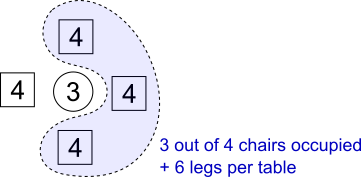Skip over navigation
Answer: 32
Count the legs around each table:

So there are 3 + 16 + 6 = 25 legs for each table.
206 legs - the 6 legs of the staff = 200 legs
200 legs = 8 tables
8 tables require 32 chairs.


Or search by topic
Number and algebra
Geometry and measure
Probability and statistics
Working mathematically
Advanced mathematics
For younger learners
A Leg to Stand On
Age 11 to 14
ShortChallenge Level 





- Problem
- Solutions
Answer: 32
Count the legs around each table:

So there are 3 + 16 + 6 = 25 legs for each table.
206 legs - the 6 legs of the staff = 200 legs
200 legs = 8 tables
8 tables require 32 chairs.
This problem is taken from the UKMT Mathematical Challenges.
You can find more short problems, arranged by curriculum topic, in our short problems collection.
You may also like
Adding All Nine
Make a set of numbers that use all the digits from 1 to 9, once and once only. Add them up. The result is divisible by 9. Add each of the digits in the new number. What is their sum? Now try some other possibilities for yourself!
Summing Consecutive Numbers
15 = 7 + 8 and 10 = 1 + 2 + 3 + 4. Can you say which numbers can be expressed as the sum of two or more consecutive integers?

